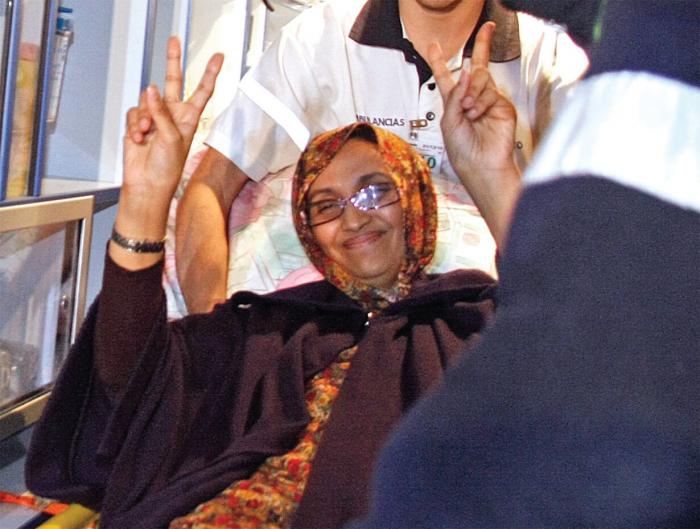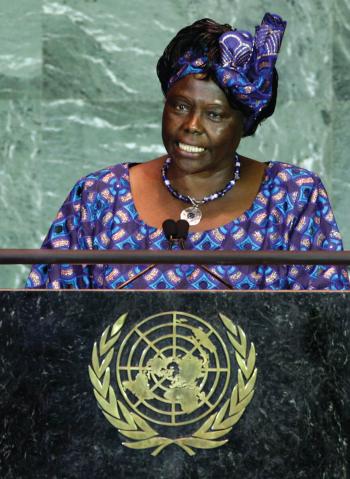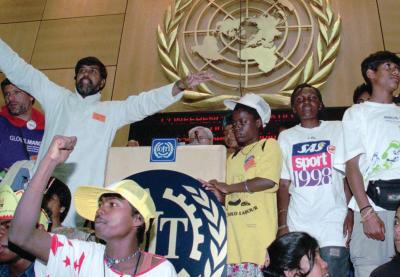For years in Western Sahara, Aminatou Haidar peacefully demonstrated against the human rights abuses of the Moroccan government. As a result, she spent four years in a detention center with 17 other women being beaten and tortured. In spite of this, Aminatou remains outspoken in her support of nonviolent resistance among people seeking independence from Morocco.

To Katherine Arredondo, 16, news of this life-and-death struggle was a revelation.
“Learning about human rights and defenders opens your eyes,” said Katherine, a junior at Brentwood High School on Long Island, N.Y. “It shows you we shouldn’t be boxed into the world we live in. If anything, it made me feel like I should do something to help.”
Katherine is just one of thousands of students who have come to understand the modern-day struggle for human rights through a curriculum called “Speak Truth To Power.” Introduced in New York State last December, Speak Truth To Power consists of 17 teacherdeveloped lessons based on the stories of rights advocates from all over the world.
The lessons were created for sixththrough 12th-grade students, and have come to New York schools thanks to the Robert F. Kennedy Center for Justice and Human Rights and the New York State United Teachers union. Speak Truth To Power is based on Kerry Kennedy’s book of the same name, and the curriculum has one simple goal: to urge students to take action.
“It’s about trying to get kids to selfidentify as human rights defenders in their community and beyond,” says John W. Heffernan, the director of the Speak Truth To Power project.
Human rights, such as freedom of speech and religion, as well as the freedom to work and associate with others, are fundamental. At the High School for Public Service in Brooklyn, many students have witnessed the struggle for those rights firsthand. About 85 percent identify as black, either African American or Caribbean, while most of the rest are Latino. Many have either lived under dictatorships or witnessed extreme poverty.
Principal Ben Shuldiner said that when a group of human rights defenders spoke at the Title I school last year, it was an inspirational moment for the students. In response, some ninthgraders undertook a project that focused on health and nutrition in their community. They began working with the city and local grassroots groups to run a one-acre farm. It supplies fresh produce in an area with serious nutrition problems. The students also conduct public service announcements to promote good eating habits.
“When they do something positive for their community or family, they feel like they have power and that they can do good,” says Shuldiner. He said that the newfound confidence often translates into better academic performance.
The Speak Truth To Power curriculum, introduced in 2003, has spread all over the United States, as well as to countries in Europe and Africa. In Italy, the program is part of a 12-week course that hundreds of thousands of students have taken part in. In February, the program was launched in Hong Kong and Cambodia.
Finding time to use the Speak Truth To Power curriculum can be difficult when schools face pressures to excel on standardized tests, says Richard C. Iannuzzi, president of New York State United Teachers. But he believes lessons about civil liberties and social justice are now on everybody’s radar given current global economic problems and freedom movements in countries like Egypt and Syria.
At Brentwood High School in Long Island, English teacher Pamela O’Brien uses Speak Truth To Power to enrich the district’s curriculum. Students in the district come from 149 countries and speak 79 languages.

O’Brien’s students recently raised and donated $1,000 to a group that educates people about child labor. The students researched Kailash Satyarthi and his work for the abolition of child slavery in India. Satyarthi is one of the human rights defenders in the Speak Truth To Power curriculum.
Amanda Butera, a 15-year-old sophomore at Brentwood, admits that she knew little about child labor or social justice issues before joining this effort. “I think it made me a better person,” she says. “I feel like I’m actually becoming part of something that’s going on.”
O’Brien says that stories about human rights leaders help the students develop a stronger sense of empathy. Students at Brentwood have also helped organize aid for the people of Haiti. And they have developed lessons based on the work of Wangari Maathai (shown right), a Kenyan environmental and political activist, whose Green Belt movement earned her the 2004 Nobel Peace Prize.
“One of the things that binds us as human beings and distinguishes us from animals is the drive we as human beings have in the search for the meaning of our existence,” says O’Brien, “and the ability and choice to speak the truth or not.”
